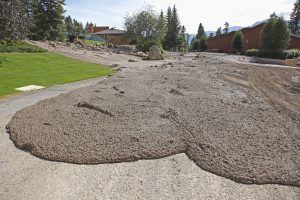 Last week, the Ohio Supreme Court unfortunately narrowed the scope of coverage for a subcontractor’s faulty workmanship. The court held in Ohio Northern University v. Charles Construction Services, Inc. that faulty workmanship in a construction defect case is not an “occurrence” under standard-form CGL policies in Ohio. The circumstances will sound familiar to anyone involved in the construction industry: Ohio Northern University retained Charles Construction to build a hotel and conference center on campus. The contract required Charles to maintain a CGL policy with Products-Completed Operations-Hazard coverage. Charles obtained a policy from Cincinnati Insurance Company with the required coverage.
Last week, the Ohio Supreme Court unfortunately narrowed the scope of coverage for a subcontractor’s faulty workmanship. The court held in Ohio Northern University v. Charles Construction Services, Inc. that faulty workmanship in a construction defect case is not an “occurrence” under standard-form CGL policies in Ohio. The circumstances will sound familiar to anyone involved in the construction industry: Ohio Northern University retained Charles Construction to build a hotel and conference center on campus. The contract required Charles to maintain a CGL policy with Products-Completed Operations-Hazard coverage. Charles obtained a policy from Cincinnati Insurance Company with the required coverage.
Articles Posted in States
Electing to Pay One Claim Over Another to an Insured’s Detriment Could Subject Insurers to Bad Faith Claims
 A federal court in Michigan just breathed new life into a long-running legal saga—while at the same time issuing a warning shot across the bows of insurers—by declining to dismiss an insured’s bad faith cause of action alleging its insurer wrongly decided to pay one claim before another, to the insured’s detriment.
A federal court in Michigan just breathed new life into a long-running legal saga—while at the same time issuing a warning shot across the bows of insurers—by declining to dismiss an insured’s bad faith cause of action alleging its insurer wrongly decided to pay one claim before another, to the insured’s detriment.
New York’s Highest Court Delivers a Blow to Policyholders in Allocation of Long-Tail Liability Coverage
 The conflict between policyholders and insurers over “long-tail” insurance coverage took an unfortunate turn with a recent decision by the New York Court of Appeals on the issue of allocation for long-tail claims. On March 27, 2018, the court issued a decision in Keyspan that significantly impacts policyholders by decreasing the insurers’ proportionate share of financial responsibility and increasing the share imposed on the insured. This case involved long-term and continuous environmental contamination that began before comprehensive general liability insurance became available in the marketplace and continued, unobserved, across multiple policy periods. At issue was whether, under the “pro rata time-on-the-risk” method of allocation, Century Indemnity Company was liable to its insured, KeySpan Gas East Corporation, for years outside of its policy periods when there was no applicable insurance coverage offered on the market.
The conflict between policyholders and insurers over “long-tail” insurance coverage took an unfortunate turn with a recent decision by the New York Court of Appeals on the issue of allocation for long-tail claims. On March 27, 2018, the court issued a decision in Keyspan that significantly impacts policyholders by decreasing the insurers’ proportionate share of financial responsibility and increasing the share imposed on the insured. This case involved long-term and continuous environmental contamination that began before comprehensive general liability insurance became available in the marketplace and continued, unobserved, across multiple policy periods. At issue was whether, under the “pro rata time-on-the-risk” method of allocation, Century Indemnity Company was liable to its insured, KeySpan Gas East Corporation, for years outside of its policy periods when there was no applicable insurance coverage offered on the market.
Kentucky Supreme Court Stays in the Minority: Faulty Work Does Not Constitute an Occurrence
 A little over two months ago, we analyzed the recent decision in Black & Veatch Corp. v. Aspen Insurance (UK) Ltd., which placed the U.S. Court of Appeals for the Tenth Circuit in line with a consistently expanding number of jurisdictions finding that a subcontractor’s faulty work constitutes an “occurrence” (defined as an accident) under standard form CGL language. The Tenth Circuit’s decision emphasized the “near unanimity” of state supreme court decisions since 2012 finding that construction defects constituted an occurrence (for example, New Jersey). Days after publishing our post on the Tenth Circuit’s decision, the Kentucky Supreme Court faced the same question. But rather than join the growing trend, the Kentucky court doubled down on its previous decision addressing the issue, finding for a second time since 2010 that a contractor’s faulty workmanship was not an “occurrence” under a CGL policy.
A little over two months ago, we analyzed the recent decision in Black & Veatch Corp. v. Aspen Insurance (UK) Ltd., which placed the U.S. Court of Appeals for the Tenth Circuit in line with a consistently expanding number of jurisdictions finding that a subcontractor’s faulty work constitutes an “occurrence” (defined as an accident) under standard form CGL language. The Tenth Circuit’s decision emphasized the “near unanimity” of state supreme court decisions since 2012 finding that construction defects constituted an occurrence (for example, New Jersey). Days after publishing our post on the Tenth Circuit’s decision, the Kentucky Supreme Court faced the same question. But rather than join the growing trend, the Kentucky court doubled down on its previous decision addressing the issue, finding for a second time since 2010 that a contractor’s faulty workmanship was not an “occurrence” under a CGL policy.
CGL Insurer Can’t Avoid Covering Employer for Negligent Hiring of Employee Who Committed Intentional Wrong, California Supreme Court Says
 By statute, California law holds that willful misconduct—where an insured intends to cause someone harm—is not insurable as a matter of public policy. For years, insurance companies have sought to expand this prohibition to exclude coverage where anyone acts deliberately, regardless of the intent of the insured, or the insured’s intent to cause harm.
By statute, California law holds that willful misconduct—where an insured intends to cause someone harm—is not insurable as a matter of public policy. For years, insurance companies have sought to expand this prohibition to exclude coverage where anyone acts deliberately, regardless of the intent of the insured, or the insured’s intent to cause harm.
The Developer’s Toolbox to Manage Risk of Future Condominium Conversion
Developers need to keep an open mind to protect themselves against construction defect claims. Insurance is a vital tool, but it should not be the only one in a developer’s risk management toolbox.
Another useful tool—the ability to disclaim all liability for future construction defect claims when the property is sold to a third party and converted to condominiums—was recently upheld in South Carolina. In Long Grove at Seaside Farms, LLC et al. v Long Grove Property Owners’ Association Inc. et al., the South Carolina Supreme Court dismissed a previously accepted writ of certiorari as improvidently granted, thereby upholding the decisions of the trial and appellate courts dismissing defective construction claims brought by a condominium association against the original developer of an apartment complex.
Bad Facts (Sometimes) Make Good Law – The Worst Texting and Driving Incident Still Does Not Defeat Coverage under NY Law
Insurance agreement language that precludes coverage in CGL policies for “expected or intended” injuries has been analyzed in nearly every jurisdiction, and courts have consistently held that bodily injury or property damage is excluded only if the insurer can demonstrate resulting damage was expected or intended by the insured. In Certain Underwriters at Lloyd’s, London v. Connex Railroad LLC, an insurer-friendly variation of these provisions was called into question in possibly the worst texting and driving scenario imaginable. Still, a California Court of Appeal applying New York law refused to bar coverage.
injury or property damage is excluded only if the insurer can demonstrate resulting damage was expected or intended by the insured. In Certain Underwriters at Lloyd’s, London v. Connex Railroad LLC, an insurer-friendly variation of these provisions was called into question in possibly the worst texting and driving scenario imaginable. Still, a California Court of Appeal applying New York law refused to bar coverage.
Another Appellate Court Holds that Faulty Work Constitutes an Occurrence – This Time Under New York Law
It is axiomatic that in order to obtain insurance coverage a policyholder must first establish that a claim falls within a policy’s insuring agreement before coverage under the policy is triggered.  For construction claims brought under CGL policies, that frequently means showing that the damages at issue constitute “property damage” caused by an “occurrence” (where “occurrence” is generally defined as “an accident”). While this requirement may often seem like a simple factual question, in the context of a subcontractor’s faulty workmanship, the analysis has proven more difficult. Where alleged faulty work causes damage only to the insured’s own work product, is the property damage accidental?
For construction claims brought under CGL policies, that frequently means showing that the damages at issue constitute “property damage” caused by an “occurrence” (where “occurrence” is generally defined as “an accident”). While this requirement may often seem like a simple factual question, in the context of a subcontractor’s faulty workmanship, the analysis has proven more difficult. Where alleged faulty work causes damage only to the insured’s own work product, is the property damage accidental?
Insurance Coverage for Mudslides Shifts into Focus
As James Taylor might say, I’ve seen fire and I’ve seen rain, but will my insurance cover the damage? California has certainly seen plenty of fire and rain. In the aftermath of the state’s most recent  devastating events, damages are estimated to top $5 billion. As Californians file insurance claims to cover their losses, coverage for flooding and mudslide damage has come into focus.
devastating events, damages are estimated to top $5 billion. As Californians file insurance claims to cover their losses, coverage for flooding and mudslide damage has come into focus.
Lost in the Desert: An Arizona Court Takes a Wrong Turn on Interpreting Ambiguous Policy Language
Most states apply the rule of contra proferentem, resolving ambiguous policy language against the insurer and in favor of coverage. Insurers, after all, have control over their policy language and it is their responsibility to ensure the language is clear. Some states require the use of extrinsic evidence before resolving ambiguous language in favor of the policyholder, and many consider the reasonable expectations of the parties in interpreting policy language.
their responsibility to ensure the language is clear. Some states require the use of extrinsic evidence before resolving ambiguous language in favor of the policyholder, and many consider the reasonable expectations of the parties in interpreting policy language.
Arizona courts have applied a variant of contra proferentem. They first view the language from the standpoint of the average layman untrained in insurance. If the language can be interpreted in more than one way, courts will attempt to determine its meaning by examining (1) the language of the provision, (2) the purpose of the transaction, and (3) public policy considerations. If after that analysis the provision language is still ambiguous, the courts will construe the language in favor of coverage.
 Policyholder Pulse
Policyholder Pulse


